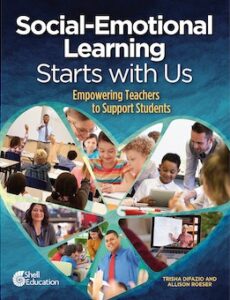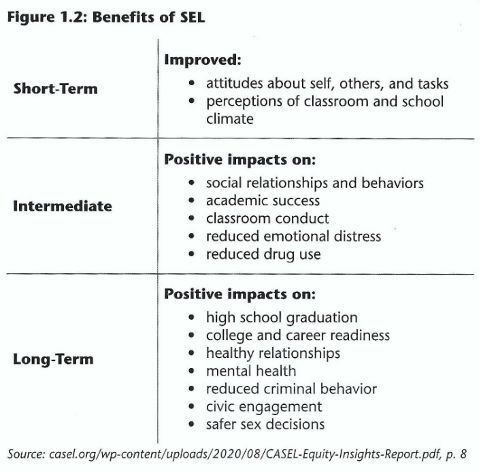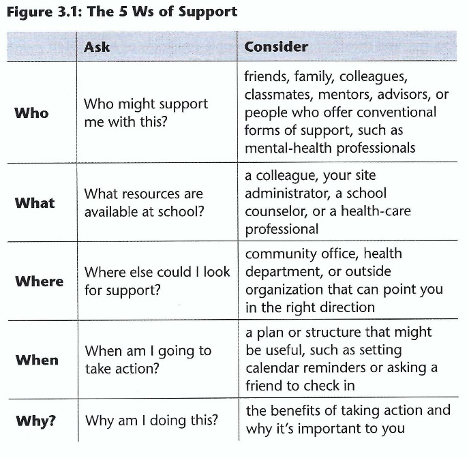SEL: Empower Teachers to Support Students
Social-Emotional Learning Starts with Us: Empowering Teachers to Support Students
By Trisha DiFazio and Allison Roeser
(Shell Education, 2022 – Learn more)
Reviewed by Anne Anderson

DiFazio and Roeser say it best on page 10 as they recall their own time as students: “It wasn’t a worksheet or a PowerPoint that made a difference in our lives; it was a person.” The practical tips and strategies included in their book will help you be that kind of person – one who makes a difference in students’ lives.

The Collaborative for Academic, Social, and Emotional Learning (CASEL) has identified five broad competencies that can be developed across cultures, from childhood to adulthood. These competencies include self-awareness, self-management, social awareness, relationship skills, and responsible decision-making. To learn more about CASEL visit www.casel.org.
The benefits of SEL (p. 18) are shown below:

- a thorough discussion of each competency and how to develop it
- captivating stories about the experiences of teachers and students
- personal inventories and reflective activities for educators
- ideas for integrating SEL and mindfulness throughout the day
- chapter summaries and discussion questions
- engaging SEL activities and reproducible pages to use with students
Chapter 1 focuses on adults and suggests ways to identify the various components of self-awareness. Readers learn more about naming and understanding emotions, having a growth mindset, and recognizing strengths in order to model them for students.
Here are some highlights from Chapter 2 where readers find this definition of self-management: “the abilities to manage one’s emotions, thoughts, and behaviors effectively in different situations and to achieve goals and aspirations.” (p. 53)
This chapter, which addresses good stress and bad stress, includes several valuable activities related to motivation. For example, having students create vision boards is one way to help students affirm specific goals. These vision boards serve as visual reminders of academic and personal goals.
SMART Goals and Beyond
Most educators are familiar with the idea of setting SMART goals; students use the acronym SMART (Specific, Measurable, Attainable, Relevant, Time bound) when creating goals. The authors suggest a second goal-setting strategy, PACT (Purposeful, Actionable, Continuous, Trackable). Setting goals is just the beginning; fortunately, the authors provide readers with five practical tips to help students overcome the obstacles.
“When we assist students in developing their capacities to seek help, practice gratitude, and demonstrate empathy, they are better equipped for professional and personal success.” (p. 81) DiFazio and Roeser remind readers to model empathy, explicitly teach empathy, and praise empathy.
According to researchers, the benefits of practicing gratitude are numerous. An easy first step is to keep a gratitude journal. Another easy activity involves setting up a center in your classroom stocked with paper, stickers, fancy pens, and markers. Encourage students to write short notes of gratitude to others.
Many people – adults and students – do not know how to ask for help. Figure 3.1 (p. 78) will help identify and find the support needed.

The topic of mindfulness is covered in Chapter 6. Again, the authors share practical suggestions for integrating mindfulness practices into daily instruction.
Chapter 7 is filled with reproducible activities for intentional SEL skill practice. Yes, there’s overlap; that’s because the competencies are all interconnected. Within the activities are suggested grade level Sentence Frames, Opportunities for Differentiation, and Student Reflection Questions. “There are multiple opportunities within each activity to validate and celebrate students’ languages, cultures, and identities.” (p.109)
Directions for accessing the digital resources in Chapter 7 are located on the last page of the book.
Social-Emotional Learning Starts with Us: Empowering Teachers to Support Students is an easy way to better connect with your students. Trisha DiFazio and Allison Roeser not only share their knowledge; they share their hearts.
Find suggestions from DiFazio and Roeser
in this MiddleWeb article:
3 Fun and Effective SEL Strategies for Grades 4-8.
Anne Anderson always knew she wanted to be a teacher. She graduated from East Texas Baptist University with an English major and History minor and did graduate work at Louisiana State University and Louisiana Tech University. After teaching 8th graders for 24 years, Anne served as a content coach. Since retiring in 2011, Anne has worked as an educational consultant, presenting at national conferences and onsite trainings for public and private schools.
Calendar Celebrations: March, April, May is part of Anne Anderson’s trilogy on quick, engaging activities and resources for months of the school year. (For MiddleWeb she wrote about selected winter celebrations here, about fall here, and about spring resources here and here.) Anne has also published articles in IDEAS Plus and Voices from the Middle, publications of the National Council of Teachers of English. She is a frequent reviewer of professional books for MiddleWeb.com.
































